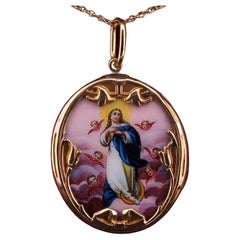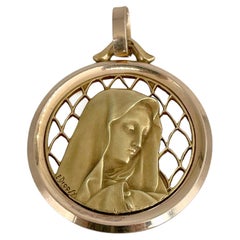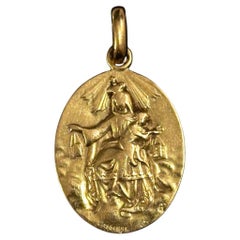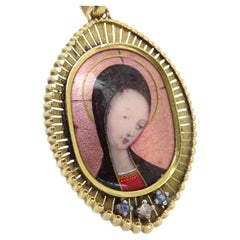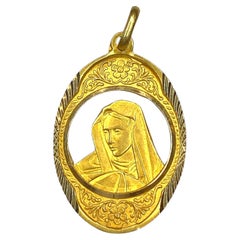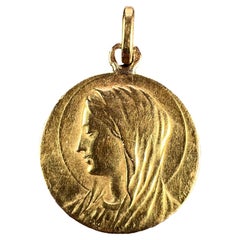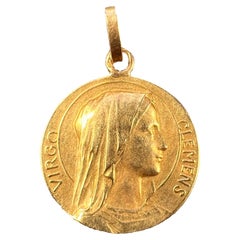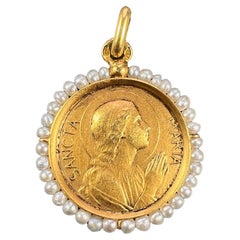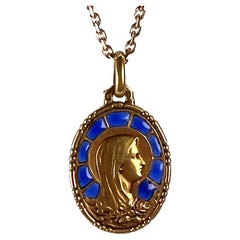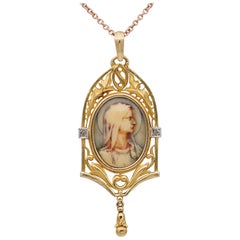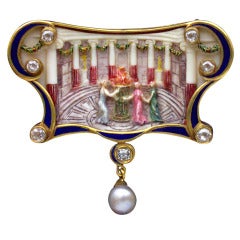Art Nouveau Jewelry Virgin
Antique Late 19th Century Hungarian Art Nouveau Pendant Necklaces
18k Gold, Enamel
Early 20th Century French Art Nouveau Pendant Necklaces
Gold
Early 20th Century French Art Nouveau Pendant Necklaces
Yellow Gold
Antique Early 1900s French Art Nouveau Pendant Necklaces
Gold, Enamel
Mid-20th Century American Art Nouveau Pendant Necklaces
18k Gold, Yellow Gold
Antique 19th Century French Art Nouveau Pendant Necklaces
Gold, 18k Gold, Yellow Gold
20th Century French Art Nouveau Pendant Necklaces
Gold, 18k Gold, Yellow Gold
20th Century French Art Nouveau Pendant Necklaces
Pearl, Gold, 18k Gold, Yellow Gold
20th Century French Art Nouveau Pendant Necklaces
Gold, 18k Gold, Yellow Gold, Enamel
Recent Sales
Antique Early 1900s Spanish Art Nouveau Pendant Necklaces
Diamond, 18k Gold
Early 20th Century French Art Nouveau Brooches
Diamond, 18k Gold
Early 20th Century French Art Nouveau Pendant Necklaces
18k Gold, Yellow Gold
Early 20th Century French Art Nouveau Pendant Necklaces
Pearl
Early 20th Century Unknown Art Nouveau Pendant Necklaces
18k Gold, Yellow Gold
20th Century Italian Art Nouveau Fashion Rings
Sapphire, 18k Gold, Yellow Gold
20th Century French Art Nouveau Pendant Necklaces
Gold, 18k Gold, Yellow Gold
20th Century French Art Nouveau Pendant Necklaces
Gold, 18k Gold, Yellow Gold
20th Century French Art Nouveau Pendant Necklaces
Gold, 18k Gold, Yellow Gold, Enamel
20th Century French Art Nouveau Pendant Necklaces
Gold, 18k Gold, Yellow Gold, Enamel
Early 20th Century French Art Nouveau Pendant Necklaces
Gold, 18k Gold, Yellow Gold, Rose Gold
Antique 1880s Art Nouveau Pendant Necklaces
18k Gold
Early 20th Century French Art Nouveau Brooches
Diamond, White Diamond, Gold, 18k Gold, Yellow Gold
Early 20th Century French Art Nouveau Pendant Necklaces
18k Gold, Yellow Gold
Early 20th Century French Art Nouveau Pendant Necklaces
Gold, 18k Gold, Enamel
Early 20th Century French Art Nouveau Pendant Necklaces
20th Century French Art Nouveau Pendant Necklaces
Gold, 18k Gold, Yellow Gold
Antique Early 1900s French Art Nouveau Pendant Necklaces
Pearl, Cultured Pearl, White Gold, Gold, 18k Gold
Early 20th Century French Art Nouveau Pendant Necklaces
Gold, 18k Gold, Yellow Gold
20th Century French Art Nouveau Pendant Necklaces
Pearl, Gold, 18k Gold, Yellow Gold
Early 20th Century French Art Nouveau Pendant Necklaces
Gold, 18k Gold, Rose Gold, Yellow Gold
Vintage 1920s Russian Art Nouveau Pendant Necklaces
Pearl, 18k Gold
People Also Browsed
Vintage 1960s Italian Retro Pendant Necklaces
Gold, 18k Gold, Yellow Gold
Antique Early 1900s Pendant Necklaces
Vintage 1940s Retro Pendant Necklaces
10k Gold
Mid-20th Century French Modern Pendant Necklaces
Gold, 18k Gold, Yellow Gold
20th Century French Pendant Necklaces
Gold, 18k Gold, Yellow Gold
Antique 19th Century European Renaissance Revival Brooches
Silver, Enamel
Antique 1890s Austrian Art Nouveau Pendant Necklaces
Ruby, Natural Pearl, Pearl, White Diamond, Diamond, Enamel, Yellow Gold,...
Antique 19th Century French Art Nouveau Pendant Necklaces
Yellow Gold, 14k Gold
20th Century French Pendant Necklaces
Gold, 18k Gold, Yellow Gold
20th Century French Pendant Necklaces
Gold, 18k Gold, Yellow Gold
20th Century French Pendant Necklaces
Gold, 18k Gold, Yellow Gold
Antique Late 19th Century European Renaissance Revival Pendant Necklaces
Silver, Enamel
1990s Cocktail Rings
Aquamarine, Diamond, Ruby, Yellow Gold
Antique Early 1900s Unknown Pendant Necklaces
14k Gold
Antique 19th Century Unknown Victorian Choker Necklaces
Diamond, Opal, Gold, Silver
Antique 1840s Pendant Necklaces
Art Nouveau Jewelry Virgin For Sale on 1stDibs
How Much is a Art Nouveau Jewelry Virgin?
A Close Look at Art Nouveau Jewelry
Art Nouveau — generally considered to have begun in the late 1800s and ended with the start of World War I — was a movement in the decorative arts that drew inspiration from natural forms, such as trees, flowers and, of course, the human figure. The three main themes present in Art Nouveau jewelry and watches were flora, fauna and women.
Art Nouveau, which reached its pinnacle in the year 1900, spawned from artists who rejected the historicism of their predecessors to create an entirely new visual vocabulary. As compared to Art Deco jewelry’s geometric patterns and sharp lines, the extravagant style of antique Art Nouveau jewelry is characterized by curvilinear forms and whiplash lines, vibrant materials and dramatic imagery.
The first art and design movement of the 20th century, Art Nouveau was also a reaction against the Industrial Revolution, and took its inspiration from the theories of the Symbolists, the art of the Pre-Raphaelites, the ideas of John Ruskin and his follower William Morris and, most importantly Japanese crafts. (The country was a fertile ground for inspiration after it was opened to the West in 1854.) The Art Nouveau style touched all manners of the arts, including the most exultant jewelry.
Nature was a favorite muse for artists going back to the 18th and 19th centuries, but in the hands of 20th-century artists, it was depicted in new ways. For example, a withering flower was considered just as beautiful as one in full bloom. Winged creatures, such as insects and birds, were also a popular subject. Dragonflies and butterflies were particular favorites because they morphed so dramatically in different life stages.
This was also a reference to women, whose role in society was evolving. It was not uncommon to see a piece of jewelry that would at once reference a woman as a winged creature (think René Lalique’s famous Dragonfly brooch, circa 1897–98, at the Gulbenkian Collection in Lisbon). However, just as women’s roles were ambiguous, so was their image, as the femmes nouvelle were simultaneously eroticized and romanticized.
In addition to Lalique, vital figures in Art Nouveau jewelry included Louis Comfort Tiffany in the United States, Vladimir Soloviev, who designed jewelry for Peter Carl Fabergé in Russia, Fuset Grau of Spain, Karl Rothmuller of Germany and Philippe Wolfers of Belgium.
Art Nouveau jewelers used every “canvas” imaginable, looking beyond brooches and necklaces to belt buckles, fans, tiaras, dog collars (a type of choker necklace), pocket watches, corsages and hair combs. Multicolored gems and enamel could complete this vision better than diamonds. Jewelers also favored pearls, particularly baroque pearls, for their large size and irregular shape. However, opal was the most popular stone — its iridescence harmonized perfectly with the enamel, and it could be carved into any shape. Art Nouveau jewelry was primarily set in yellow gold.
Find a range of antique Art Nouveau jewelry today on 1stDibs.
Why Gold Shines in Jewelry Craftsmanship
Gold is the feel-good metal, the serotonin of jewelry. Wear vintage and antique gold necklaces, watches, gold bracelets or gold rings and you feel happy, you feel dressed, you feel, well, yourself.
Gold, especially yellow gold, with its rich patina and ancient pedigree going back thousands of years, is the steady standby, the well-mannered metal of choice. Any discussion of this lustrous metal comes down to a basic truth: Gold is elementary, my dear. Gold jewelry that couples the mystique of the metal with superb design and craftsmanship achieves the status of an enduring classic. Many luxury houses have given us some of our most treasured and lasting examples of gold jewelry over the years.
Since its founding, in 1837, Tiffany & Co. has built its reputation on its company jewelry as well as its coterie of boutique designers, which has included Jean Schlumberger, Donald Claflin, Angela Cummings and Elsa Peretti. There are numerous gold Tiffany classics worth citing. Some are accented with gemstones, but all stand out for their design and the workmanship displayed.
For the woman who prefers a minimalist look, the Tiffany & Co. twist bangle (thin, slightly ovoid) is stylishly simple. For Cummings devotees, signature pieces feature hard stone inlay, such as her pairs of gold ear clips inlaid with black jade (a play on the classic Chanel black and tan), or bangles whose design recalls ocean waves, with undulating lines of lapis lazuli and mother-of-pearl. And just about any design by the great Jean Schlumberger is by definition a classic.
Even had he eschewed stones and diamonds, Southern-born David Webb would be hailed for the vast arsenal of heavy gold jewelry he designed. Gold, usually hammered or textured in some manner, defines great David Webb jewelry. The self-taught jeweler made very au courant pieces while drawing inspiration from ancient and out-of-the-way sources — East meets West in the commanding gold necklaces made by Webb in the early 1970s. The same could be said for his endlessly varied gold cuffs.
In Europe, many houses have given us gold jewelry that sets the highest standard for excellence, pieces that were highly sought after when they were made and continue to be so.
Numerous designs from Cartier are homages to gold. There are the classic Trinity rings, necklaces and bracelets — trifectas of yellow, white and rose gold. As a testament to the power of love, consider the endurance of the Cartier Love bracelet.
Aldo Cipullo, Cartier’s top in-house designer from the late 1960s into the early ’70s, made history in 1969 with the Love bracelet. Cipullo frequently said that the Love bracelet was born of a sleepless night contemplating a love affair gone wrong and his realization that “the only remnants he possessed of the romance were memories.” He distilled the urge to keep a loved one close into a slim 18-karat gold bangle.
BVLGARI and its coin jewelry, gemme nummarie, hit the jackpot when the line launched in the 1960s. The line has been perennially popular. BVLGARI coin jewelry features ancient Greek and Roman coins embedded in striking gold mounts, usually hung on thick link necklaces of varying lengths. In the 1970s, BVLGARI introduced the Tubogas line, most often made in yellow gold. The Tubogas watches are classics, and then there is the Serpenti, the house's outstanding snake-themed watches and bracelets.
A collection called Monete that incorporated the gold coins is one of several iconic BVLGARI lines that debuted in the 1970s and ’80s, catering to a new generation of empowered women. Just as designers like Halston and Yves Saint Laurent were popularizing fuss-free ready-to-wear fashion for women on the go, BVLGARI offered jewels to be lived in.
Since Van Cleef & Arpels opened its Place Vendôme doors in 1906, collection after collection of jewelry classics have enchanted the public. As predominantly expressed in a honeycomb of gold, there is the Ludo watch and accessories, circa the 1920s, and the golden Zip necklace, 1951, whose ingenious transformation of the traditional zipper was originally proposed by the Duchess of Windsor. Van Cleef's Alhambra, with its Moroccan motif, was introduced in 1968 and from the start its popularity pivoted on royalty and celebrity status. It remains one of VCA’s most popular and collected styles.
Mention must be made of Buccellati, whose name is synonymous with gold so finely spun that it suggests tapestry. The house’s many gold bracelets, typically embellished with a few or many diamonds, signified taste and distinction and are always in favor on the secondary market. Other important mid-20th-century houses known for their gold-themed jewelry include Hermès and Ilias Lalaounis.
Find a stunning collection of vintage and antique gold jewelry on 1stDibs.
Finding the Right Pendant-necklaces for You
Whether you’re layering multiple jewelry pieces or opting for a single strand, vintage pendant necklaces are versatile accessories that can elevate your casual wear as easily as they can add a creative flourish to your formal attire.
The earliest jewelry was less about accessorizing than it was about wearers arming themselves with amulets. In Ancient Egypt, some amulets featured a loop so that they could be strung around one’s neck. While rubies have long been one of the few gemstones that can give diamonds a run for their money, members of some ancient civilizations valued the stones from the get-go, donning ruby pendants as well as other stones with the belief that these adornments would bring protection, healing powers or strength. Today, we still wear our charm bracelets and charm pendants around our necks for good luck.
Later, pendant necklaces, like most fine jewelry, were worn strictly by royalty or the upper class and conferred wealth and prestige. This changed over time, thankfully, as wearing jewelry became more widespread, a democratized means of personal expression.
During the 18th and 19th centuries, pendant necklaces evolved from their status as spiritual amulets, but the jewels still carried deep personal significance. Victorian pendants, in particular, were part of the “mourning jewelry” tradition. Wearers would embed their pendants with locks of hair from a deceased loved one as a way of grieving in the wake of a loss. In the case of cameo jewelry, some pendants were even decorated with miniature hand-carved portraits in a detailed raised relief. Today, portraiture is still a characteristic of many of the hand-carved pendant necklaces offered by Italian jewelry house Scala Gioielli.
Luxury fine jewelry brands such as Cartier, BVLGARI and David Yurman offer their own unique interpretations of the cherished accessory, embellishing platinum or gold pendant necklaces with diamonds, sapphires and other stones.
On 1stDibs, find an extraordinary range of vintage pendant necklaces and other necklaces today.
- What is Art Nouveau jewelry?1 Answer1stDibs ExpertNovember 2, 2021Art Nouveau jewelry generally featured three main themes: flora, fauna and women. The Art Nouveau movement lasted 15 years and it reached its pinnacle in the year 1900. Art Nouveau jewelers used every “canvas” imaginable, looking beyond brooches and necklaces to belt buckles, fans, tiaras, dog collars (a type of choker necklace), pocket watches, corsages and hair combs. Multicolored gems and enamel could complete this vision better than diamonds. Enameling is most often associated with Art Nouveau jewelry, specifically plique-à-jour. Known as backless enamel, plique-à-jour allows light to come through the rear of the enamel because there is no metal backing. It creates an effect of translucence and lightness. Shop a collection of antique and vintage Art Nouveau jewelry from some of the world’s top jewelers on 1stDibs.
- 1stDibs ExpertAugust 20, 2024To identify Art Nouveau jewelry, first consider its overall shape and themes. Flora, fauna and female figures were the three main themes in Art Nouveau jewelry. Winged creatures, such as insects and birds, were also popular subjects. Next, examine the materials and techniques. Art Nouveau jewelers distinguished themselves from their predecessors through the use of their unorthodox materials and methods. Prior to the 20th century, artisans working with jewelry prioritized precious metals and diamonds. This was not true for Art Nouveau creators. Enameling is most often associated with Art Nouveau jewelry, specifically plique-à-jour. Known as backless enamel, plique-à-jour allows light to come through the rear of the enamel because there is no metal backing. It creates an effect of translucence and lightness. Art Nouveau jewelers also favored pearls, particularly baroque pearls, for their large size and irregular shape. However, opal was the most popular stone, and Art Nouveau jewelry was primarily set in yellow gold. If you need more help identifying your jewelry, a certified appraiser or knowledgeable dealer can assist you. On 1stDibs, find a wide range of Art Nouveau jewelry.
